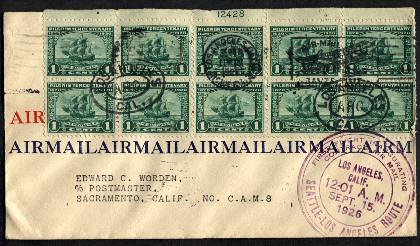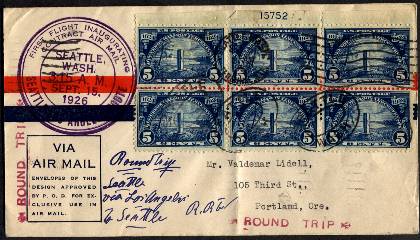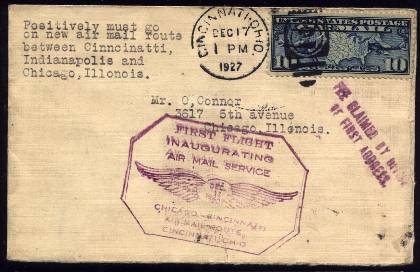

F is for Firsts - Page 3 |

|

|

|

|
First Flights
In the early days of the development of airmail service in the US, the inauguration of a new air mail route was a major event, often accompanied by ceremonies and souvenirs. The first official route, from Washington, DC to New York City, was inaugurated in 1918, but it took until 1924 before the first official coast-to-coast Air Mail service was established. With primitive planes, few airports, no radar, no CAB, no air traffic controllers - none of the things we take for granted - every flight, even over an established route, was an adventure. If the topic interests you, I recommend Aerial Mail Service, by A. D. Jones, published by the American Air Mail Society, and Turk Bird, by James H. Bruns, published by the National Postal Museum.
First Flight souvenirs became popular, and both the postal service and the airlines
aided collectors by providing special service for First Flight Covers. The dates of
first flights on new routes were published. One could submit a cover, marked to show the
flight one wanted it carried on, and addressed to General Delivery at the flight
terminus, with a return address on the back, and a note "Return to Sender". In the
earliest days airline pilots signed such covers. At the originating end of the flight,
the post office applied appropriate handstamps and/or cachets, and made sure the covers
were placed on the proper flight; at the receiving end such covers were back-stamped to
prove they had actually travelled on the designated flight. Finally, the postal clerk on
the receiving end would, as requested, return the cover, sometimes with a "Return to
Sender" handstamp, but often without, preserving the integrity of the souvenir. Note
that nothing like an RPO cancel existed, so the whole arrangement was somewhat a matter
of faith. In later days one did not need to use the General Delivery method, the system
was more like First Day Covers: one sent the cover to the city of orgination, addressed
to oneself, and it was cacheted, flown, and forwarded from the flight terminus to the
address on the envelope.
First Flight covers used to be available routinely as souvenirs of the opening of a new
route, somewhat as First Day Covers are still available, and they used to be a popular
collecting area, but the USPS stopped supporting their creation a few years ago, so they
may lose their appeal. The ones above interest me for additional reasons: the first two
are franked with plate blocks that
are scarce on cover, while the third has that rather dramatic typed admonition
("Positively must go on new air mail route...") - apparently it worked, unlike
this one, ("Dispatched
by train to avoid delay.")
If you would like to see some First Flight covers on which the cachet includes a train(!?),
click here.
"First flying machine from Washington!"
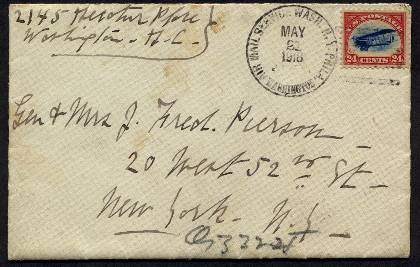
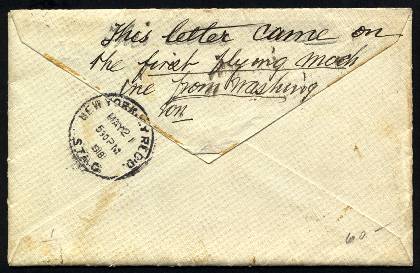
This rather dirty, not particularly distinguished cover is a favorite of mine. It is
not a First Day cover for its stamp - that would be May 13, 1918, about a week earlier
than May 21, when this cover was mailed. But it has that charming notation, written by
the recipient on the back - "This letter came on the first flying machine from
Washington", and it contains a brief letter that begins "Our greetings to you, dear
friends, by The Air Ship Mail Service." It goes on to mention hospitals and
convalescences, obviously in reference to WWI, which had not yet ended. The full text of
the letter is available here.
If you would like to read an interesting account of the early days of aviation and
airmail in the US, I recommend this page -
http://www.navfltsm.addr.com/howitbegan.htm
First Xmas stamp


Canada Scott 85 and 86
This was the world's first Christmas stamp, in 1898, and has an interesting story, which
may be apocryphal, but is fun nonetheless. The purpose of this stamp was to mark the
inauguration of Imperial Penny Postage throughout the British Empire (2 cents Canadian was
equal to 1 penny GB), and the original design did not include the inscription
"XMAS 1898." Its intended date of release, moreover, was the birthday of Queen
Victoria's son, the Prince of Wales, later to become King Edward VII. But when the
British Post Master General was asked by the Queen when Imperial Penny Postage would become effective,
and he replied "On the Prince's birthday", she replied with obvious disapproval "And what
Prince would that be?" (The Prince of Wales was not Victoria's favorite.)
Thinking fast, the PMG replied "Why, the Prince Of Peace, Your Majesty, of course." So
the release date was changed, and this stamp had the extra inscription added. The
stamp's usual name is the "Canadian Map Stamp," and it was remarkable for its day not
only for its issue date, but also for its use of three colors. (Yes, Imperial Penny
Postage did begin on that date.)
The change of the oceans' color (from pale lavender to ocean blue) was not intentional, but this was the first multi-color stamp Canada Post had attempted, and color variations were common in those days, so the mystery is not why they exist but why Scott chose to give them two separate numbers. Experts recognize at least four colors to the oceans, plus many other variations in color and design, so why stop at two? Autre temps, autre moeurs.
(Another web page with a more detailed version of the story of this stamp.)
Purists don't consider this a true Christmas stamp, since its purpose was to celebrate
Penny Postage, not Christmas.
Learn more about Christmas stamps at the site of the
Christmas Philatelic Club.
Finally, collector and Map Stamp specialist extraordinaire Ralph E. Trimble
has published a delightful web page about the many design variations on this stamp -
GO HERE.
Recent US Firsts
The USPS seems to have been "pushing the envelope" with its designs and technology lately. Here are three examples of important firsts - the first US triangle stamps, issued in 1997 to advertise Pacific 97 (Ninth International Stamp Exhibition in the US); the first US stamp with a key part of the design created by actually cutting paper away from the stamp (the silhouette of Alfred Hitchcock in the upper left corner of the stamp released in his honor in 1998); and the first US semi-postal (the Breast Cancer Awareness stamp, also released in 1998).
First US Triangle Stamps
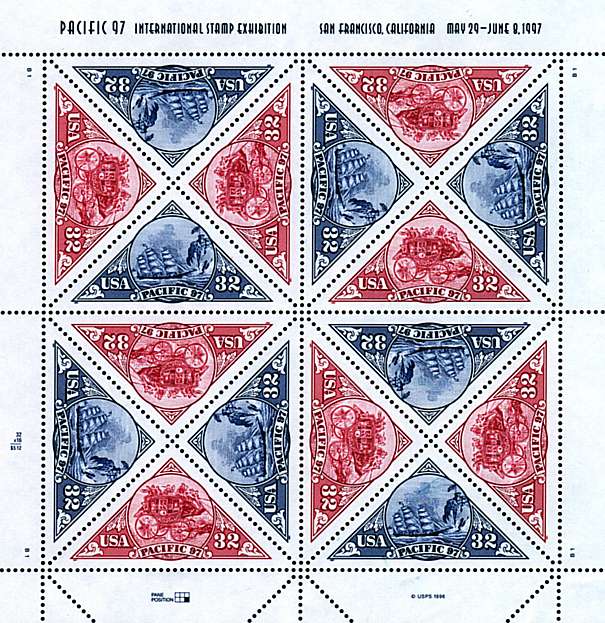
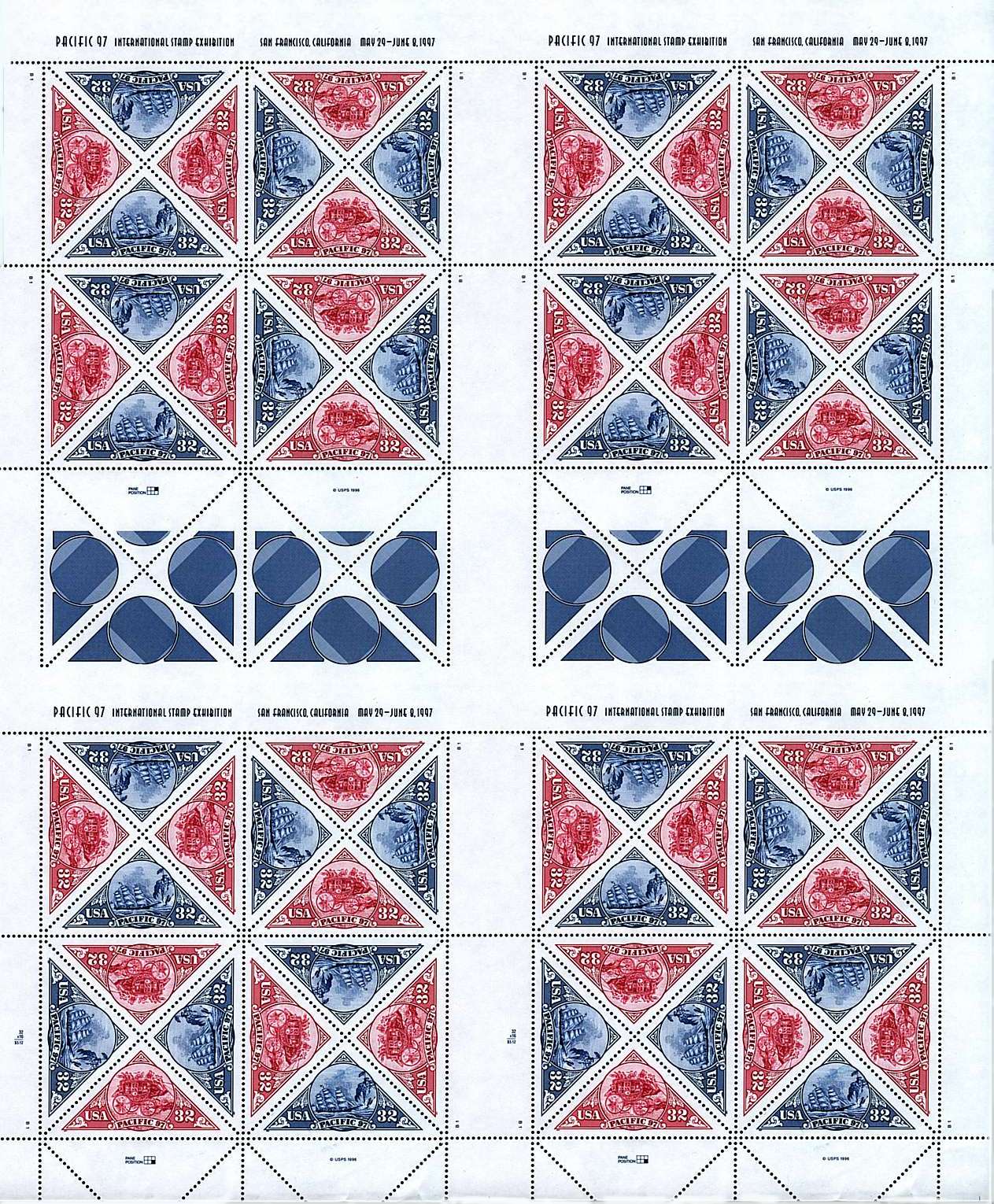
Full pane of 16
Press sheet of four panes
Unusual shapes are usually considered just a modern gimmick with stamps - Tonga was notorious in the 1960's and the 1970's for its stamps shaped like bananas, coconuts and watermelons. But the first triangle stamps were issued in 1853 by the Cape of Good Hope (now a part of the Union of South Africa), and the shape has been used with unusual restraint and good taste since. Often its goal has been to distinguish its stamp's purpose, usually for Air Mail.
It seemed an appropriate choice for these USPS stamps in honor of Pacific 97. And it provided an opportunity for a very creative and attractive layout, as well as some interesting but ultimately puzzling doodling on the full press sheet that was also available. By the way, the design was recycled from one created (but rejected for lack of time) for the Centennial Olympic Games stamp in 1996. Read the fascinating story in George Amick's excellent Linn's Stamp Yearbook for 1996.
First Cutouts on US Stamps
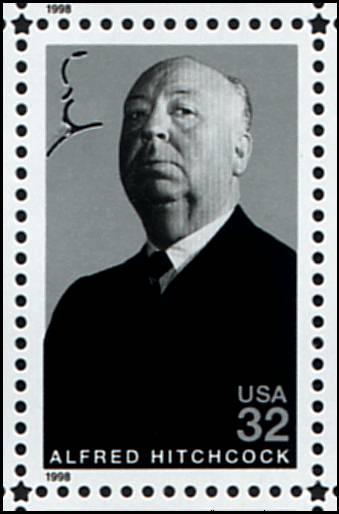

Silhouette in top left corner of stamp is a diecut - you can see the paper behind showing through!
Modern technology makes it easy to produce innovative design features that would have
been impossible only ten or fifteen years ago.
The silhouette cutout on the Alfred
Hitchcock stamp is a clever example, though in fact it is produced by the same process
that creates the perforations - including the stars in the corners of the stamp.
Rather
than being punched out by pins, as in the older production method, all the missing paper
on these stamps is removed by a grinder.
First US Semipostal Stamp
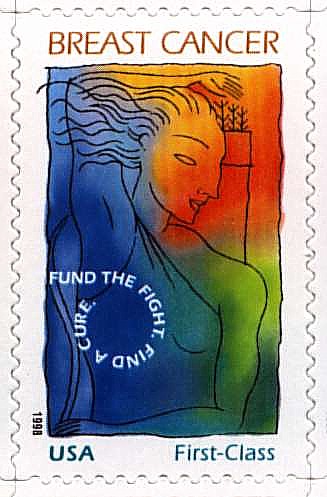
Semipostals have been common in Europe for many years, but are not popular with most collectors, who feel they are unfairly taxed by such issues, in effect compelled by their desire for a complete stamp collection to subsidize causes they might prefer not to support. This first US semipostal was heralded as the "opening of the flood gates," and a sure failure, but sales have been good; and while Congress has mandated that more should be issued, they have also given the USPS control over the program. The original plan was for one every two years through 2010. So thus far it seems none of the ill predictions has proven true. To date (July, 2013) we have four U.S. semi-postals, the original one for Breast Cancer research (still on sale, thanks to some very aggressive lobbying by California Senator Diane Feinstein); Heroes of 2001, for the familes of the 9/11 rescue personnel victims (no longer available); Stop Family Violence, to fund programs to fight domestic violence (also off sale), and Save Vanishing Species (still on sale), a wildlife conservation stamp to fund the Multinational Species Conservation Fund.
Lest I seem too optimistic and naive, however, I should note that the Breast Cancer
Research lobby is campaigning to have their stamp kept available indefinitely - the
USPS made the mistake of pushing it too hard by reprinting it and leaving it on sale too
long, I think. Other countries treat these more like commemoratives, with small fixed printings and/or limited sale dates.
They also issue many more, of course, so I'd better shut up - from a collector's point of
view, the U.S. approach is much better.
First Dive!
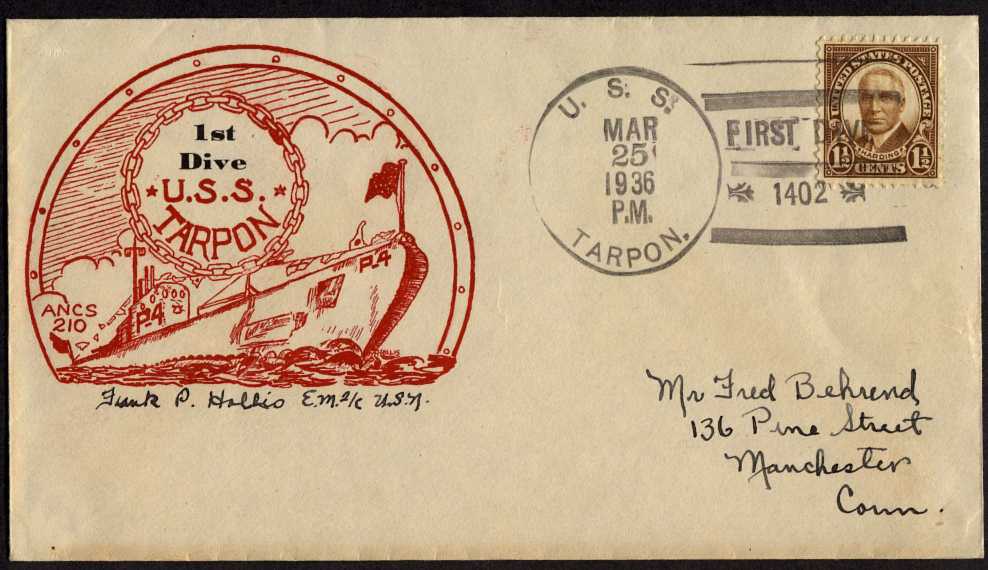
And yes, there are even First Dive covers. When you're going to be stuck inside a submarine
for six months or so, you take entertainment wherever you can find it!
| Home | F - page 2 <<< | Contents | >>> G is for G stamp | Credits |
All Letter images Copyright © 1997, 2000, SF chapter of AIGA
All text Copyright © 2000, William M. Senkus
Send feedback to the webmaster: CLICK HERE
Revised -- 01/18/2007
